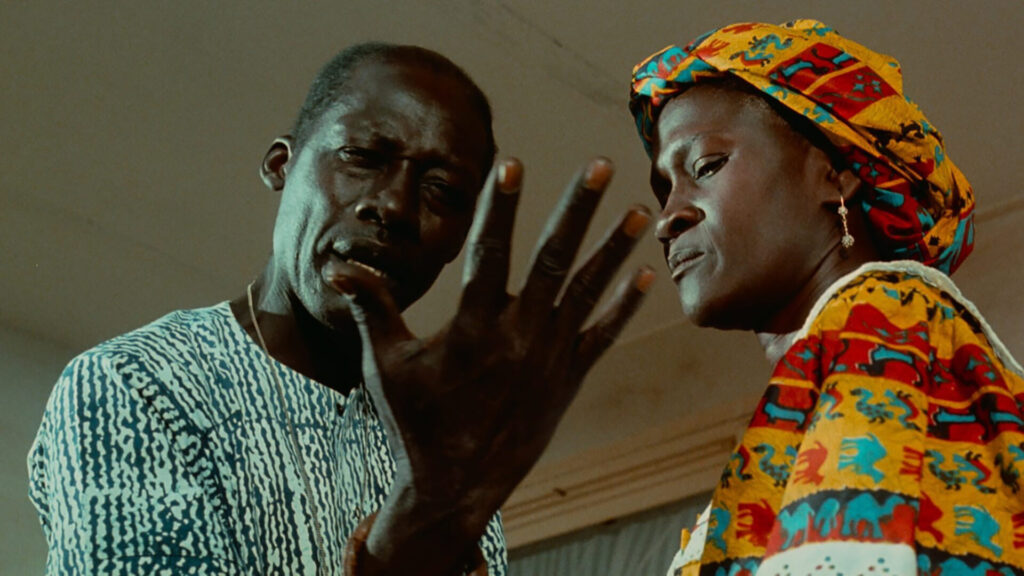Guelwaar is two films for the price of one. On the one hand, it’s a simple story of a comic mix-up. Pierre Henri Thioune, also known as Guelwaar (“the noble one”) has died, but the morgue accidentally released his body to another family, who buried him in their village’s graveyard. The problem is the Catholic Thioune was interred in a Muslim cemetery. Much consternation ensues, especially when the brothers of the Muslim who was supposed to be buried refuse to allow exhumation of the body. They take it as a grave (heh) insult, accusing the Christians of wanting to desecrate their hallowed space.
The brothers are characters full of pride, and it’s this pride that drives everything that happens in Guelwaar. Thione’s oldest son Barthélemy is now a Parisian, arriving in a fashionable European suit. He waves his French citizenship around, hoping to impress the provincials. Thione’s daughter works as a prostitute in Dakar because her pride believes it’s better than begging.
Pride, though, has two sides, and that’s where the second film—an angry manifesto—draws its power. Thioune, we learn, was no ordinary villager. He spoke out loudly and often against Western food aid. A person’s hand, he said, either points the way or opens for handouts. These handouts make slaves of his fellow Senegalese. Lest you think Guelwaar’s beef is with Europeans, it’s made clear that the enemy are the village chiefs and the politicians. They hold out Western food aid as evidence of their influence and generosity, even as they misappropriate it for their own benefit.
Writer-director Ousmane Sembène has skillfully intertwined the breezy comedy with the didactic message film. He does this with some very dry humor. When Barthélemy goes to see the village gendarme Gora, we get this exchange:
“My father’s body has disappeared from the morgue!”
“Maybe he recovered.”
Gora says this so matter-of-factly, we wonder if reanimated corpses are a regular occurrence. Later, when Barthélemy pushes his European passport in Gora’s face, the cop stops the car in the town center. The surprised Barthélemy asks why they’re not continuing to his family’s home, and Gora answers it wouldn’t be right to use Senegalese petrol to drive foreigners around. He helpfully suggests Barthélemy take any problems he has up with the French embassy.
Guelwaar, we learn, was not only a firebrand, but also a tomcat. He seduced the wife of the muezzin, leading to a funny scene where he bursts out of a straw hut, naked, with the Muslim’s friends in hot pursuit. That caper did little for Christian-Muslim relations in the region. His widow has an excellent scene where she speaks to the dead man’s empty funeral suit. Unlike the other flashbacks, this scene stays on actress Mame Ndoumbé Diop’s anguished face as she both berates Guelwaar for his ill treatment of her and mourns her husband’s love.
Two pivotal characters are the Catholic priest and the Muslim imam. They represent the best of humanity in this film. The priest listens to the life story of a prostitute, the friend of Thione’s daughter. She has shown up for the funeral in a backless dress, and after a masterfully blocked scene where she refuses to face the priest, Father Léon advises she change into something more appropriate, to which Sophie cries out, “I’m ashamed!” The imam tries to reason with the brothers, who threaten both him and the village chief with the loss of their posts. He meets with the leaders of the Christians, lamenting that “our ancestors knew how to deal with these things. What’s happening to our people?”
Guelwaar has much to offer as both a story and an indictment of how the West keeps Senegal and its neighbors dependent. Sembène is not blind to the cultural problems which plague his region—“Quelle Afrique!” (“That’s Africa!”) is a common refrain. But the Senegalese master, who’s been working since the 1960s, also offers up some subtle cinematic touches. At the film’s start, it seems flies are everywhere, nettling the “civilized” Barthélemy at every turn. These flies are not random, and when they return at the movie’s end, we realize the spirit of Guelwaar has been with us the whole time. Restrained tracking shots frame compositions that emphasize Thione’s characterization of hands that either create or beg. The first half of the film is briskly paced as it introduces the colorful characters. But then as the situation stalemates, the movie becomes more somber, deliberately transitioning us into the Guelwaar’s world. That world is one where Catholics and Muslims almost come to blows when really they should be taking up arms against the condescending West.
When I saw Guelwaar, it struck me because it was both deliriously exotic and highly familiar. The plot reminded me of Do the Right Thing, with its large cast of varied personalities on the verge of ethnic conflict. And yet both the setting and Sembène’s unabashed preaching distinguished this as a film from another world, one where lectures and exhortations are laudable provided they’re skillfully delivered. It’s a fun movie, and even the slower second half keeps you wondering which version of pride will win. Will Muslims and Christians go to guns and clubs or will they recall the comity of their ancestors? Will the Frenchman embrace his Senegalese heritage? Will the villagers embrace Guelwaar’s message of self-sufficiency? Watch and find out. Quelle Afrique!
Guelwaar is available to watch on the Criterion Channel and also here: https://www.youtube.com/watch?v=_2uhwkcdFO8

